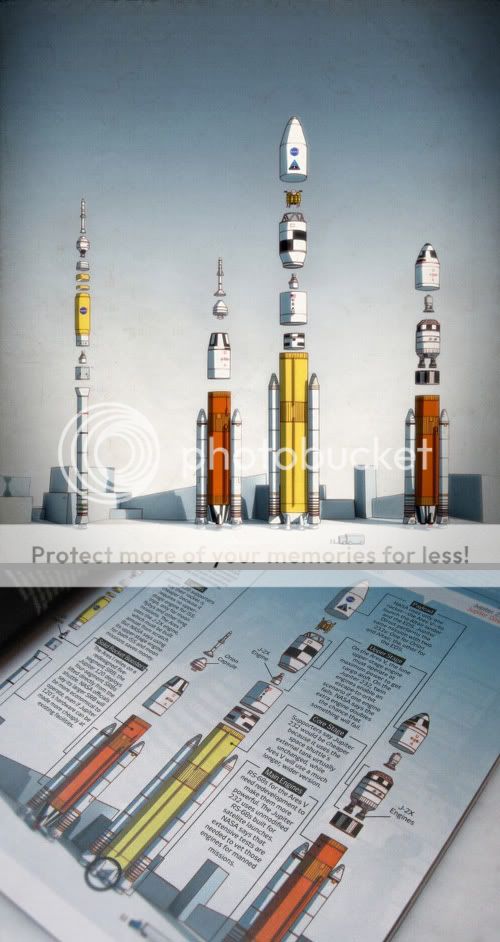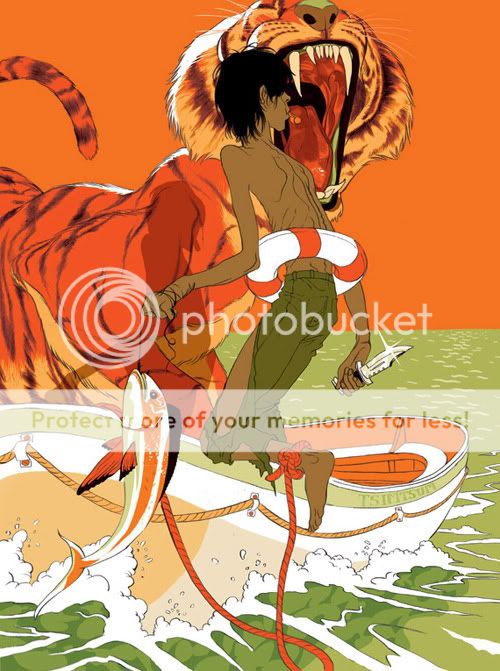I love Geco Hirasawa's work! Why, you may ask? Because it's chock full of eye candy. So much eye candy in fact, that it makes my eyes bleed. And for once, that's a good thing!!
Here's what I know about Geco Hirasawa: She's known as "Hira Geco" in deviantART, and is said to be living in Tokyo, Japan.
According to her recent journal post, she draws her linework in pencil and colors the whole thing in Adobe Photoshop. The whole process takes about two to three days, depending on her mood...
Some of her major influences include photgraphers Robert Capa Van Der Elsken (could explain the fascination with perspective?). She apparently doesn't have a favorite artist (besides the obvious Tezuka and Miyazaki) and takes inspiration more from real life (TM), various photography books, and the like.
She's been honing her skill for the past five years, and dreams of becoming a professional illustrator. Unfortunately, she laments that her style doesn't suit the Japanese market that well.
What is the word the Japanese commonly use for times like these? Ah... Ganbare, Hira Geco!!
To see more of Hira Geco's work, check out here deviantART profile! If you like her stuff, then by all means support her!
Here's what I know about Geco Hirasawa: She's known as "Hira Geco" in deviantART, and is said to be living in Tokyo, Japan.
According to her recent journal post, she draws her linework in pencil and colors the whole thing in Adobe Photoshop. The whole process takes about two to three days, depending on her mood...
Vocaloid in Space.
Some of her major influences include photgraphers Robert Capa Van Der Elsken (could explain the fascination with perspective?). She apparently doesn't have a favorite artist (besides the obvious Tezuka and Miyazaki) and takes inspiration more from real life (TM), various photography books, and the like.
She's been honing her skill for the past five years, and dreams of becoming a professional illustrator. Unfortunately, she laments that her style doesn't suit the Japanese market that well.
To see more of Hira Geco's work, check out here deviantART profile! If you like her stuff, then by all means support her!
Nook. Great illustrator. Got featured in several magazines including iDN and ImagineFX. Collaborated and produced a wonderful artbook featuring two hundred illustrators (for a cause to boot!). Did a lot of 3D stuff as well which seems to blend the 2D stuff pretty well. Does a lot of commercial work for various companies. Sorry, I'm not in the mood to do a grammar check.
One of Nook's early works in '07, the "Sakura Spaceman"
"Damn Cherry Blossoms!"
The bulk of his illustration work can be found at his profile in Behance, which is cool because he provides detailed descriptions about his artistic process and how he released his work to the adoring masses.
An example of the man's work in progress
Cool diagram for Popular Mechanics
A simple enough question. What does the denizens of ConceptArt.org think of "tracing" as a method of learning?
Gocke posed this question in the forum, and noted three ways to look at "tracing"
- I read that tracing an image teaches you a lot more than simply referring to the image by looking at it.
- Others claim it will hinder your progress and will not really teach you anything about drawing.
"First of all is learning your mind that things ain't off when doing foreshortening. I did a foreshortened beak of a bird of prey a couple of weeks ago and my mind complained a lot about stuff being off. It's only at the end that things fell into place and turned out to be ok. When making various partial traces of such an object it's possible to learn your brain that those 'odd' lines are actually ok.
The second usage is for quick setup of things.
If I want to practice values, shading and rendering I could trace the same image a couple of times to try different things.
Last and not to be underestimated. Tracing can learn you to make steady single lines. Doesn't matter on sketches, but when you are going to ink something you might want to have a steady hand..."
Arshes Nei pointed out the possibility of confusion with the subject:
"I refer to what you're talking about "Eyeballing"
Tracing is well actually going over the lines. If I for example, made some pencils and wanted to ink them, I'd get my lightboard and trace over the image. Does that count as cheating?
I want to make that distinction because it tracing and eyeballing are two different things in my opinion. It's one thing to trace over an image using a projector or light board, it's completely different to learn how to see spacial relationships to learn better control through observation and eyeballing.
I think you'll learn better this way..?
It also irks me because n00bs will interchange the term when I'm saying "ok gotta trace this" and I'm referring to my own works and they scream "cheating" when I have to explain to them. No, I'm inking, and I want to keep the original pencils around in case I mess up."
joyproject simply states:
"Tracing is fine for learning, but don't end up using it as a crutch."
OmenSpirits concurs:
With tracing, one can learn about the landmarks on the body.
The rest more or less said its cheating. Still, you can read more at http://conceptart.org/forums/showthread.php?t=154586 or http://www.conceptart.org/forums/showthread.php?t=113058 which is an older thread on the same topic.
My thoughts
So what do I think of tracing? Is it good or bad for an artist's development? Let me put it this way... it... depends.
Many artists believe that anyone caught tracing a reference photo shouldn't even be called artists. That this whole tracing business should be left to kids. Not so for the legendary DC/Marvel artist Neal Adams, who believes tracing is one of the keys to better looking art. According to a section in Neal Adam's webpage, he was quoted saying that "...if they really want to learn to draw better. The first thing you need to do is get yourself a tracing pad and some solid and clear photos from magazines and anywhere you can get them. Trace, trace, trace. Trace some more. Make it a regular part of your drawing process. You will learn more by tracing than anything else. When people hear this their immediate reaction is 'I'm not gonna trace, that is cheating.' It is not. This is how you will learn."
So like I said... It depends.
Do you know Tomer Hanuka? According to the innumerable sites that talk about this award-winning illustrator, he's worked with Time Magazine, The New York Times, Rolling Stone, MTV, among others. He's done a great deal of work in the funny book and fashion industry as well. According to an interview at formatmag, he got hooked on comics pretty early in his childhood in Israel.
The "...whole idea of superheroes, visual icons, worlds within panels" fascinated him in his youth, and that's when he decided to pursue creating his own stories in the medium. After his mandatory service in the Army, he decided to pursue art as a career and enrolled at New York's School of Visual Arts. Mr. Hanuka describes living and studying (and eventually teaching) at New York as the "...ultimate growing experience in the way it’s set up for the young and hungry to become comfortable and still hungry."
His longtime collaborators Lorenzo Mattotii and Nicolas de Crecy have proved most fruitful throughout his career. He keeps close ties with his brother, Asaf, (he's based in France) and collaborated on a number of projects on life in Israel.
Did I mention that he absolutely loves the medium of comics? Mr. Hanuka stated that he drew inspiration from "... art... books, movies, and images." He states "...Can you imagine your life without them? We are all made of other people’s dreams, our memories, a song that reminds us of that girl, a chain link of associations flicker endlessly in our psyche, all fused with culture we’ve consumed at one point and all 100% authentically ours."
When questioned in another interview done by Quiet Color about contemporary illustration, and the trends he has seen in wake of the recession, he believed that "...illustration is becoming very trendy is in advertising, in places that we’re not short of the classic places in terms of the aesthetic space they used to create."
He goes on to state how "...a lot of the corporate world taking street creds from graffiti artists and putting it on sneakers and putting it on billboards to get cool points in a very cynical way. And there’s a lot of like that anti-craft, scruffy, un-digital, unrefined illustration that finds its way into advertising big time." Wow. "Magazines are shrinking, newspapers are shrinking but advertising is growing for illustration… nobody believes photographs anymore because there is so much Photoshop, so a drawn image is suddenly a silver bullet exploding hearts of unsuspected preteens and other desired market shares."
You can read more about the aforementioned interviews at:
FORMATMAG: TOMER HANUKA
Be sure to go the man's site and learn more about his current work!
www.thanuka.com
And check http://tropicaltoxic.blogspot.com/ to learn about the man's process.
The "...whole idea of superheroes, visual icons, worlds within panels" fascinated him in his youth, and that's when he decided to pursue creating his own stories in the medium. After his mandatory service in the Army, he decided to pursue art as a career and enrolled at New York's School of Visual Arts. Mr. Hanuka describes living and studying (and eventually teaching) at New York as the "...ultimate growing experience in the way it’s set up for the young and hungry to become comfortable and still hungry."
His longtime collaborators Lorenzo Mattotii and Nicolas de Crecy have proved most fruitful throughout his career. He keeps close ties with his brother, Asaf, (he's based in France) and collaborated on a number of projects on life in Israel.
Did I mention that he absolutely loves the medium of comics? Mr. Hanuka stated that he drew inspiration from "... art... books, movies, and images." He states "...Can you imagine your life without them? We are all made of other people’s dreams, our memories, a song that reminds us of that girl, a chain link of associations flicker endlessly in our psyche, all fused with culture we’ve consumed at one point and all 100% authentically ours."
When questioned in another interview done by Quiet Color about contemporary illustration, and the trends he has seen in wake of the recession, he believed that "...illustration is becoming very trendy is in advertising, in places that we’re not short of the classic places in terms of the aesthetic space they used to create."
He goes on to state how "...a lot of the corporate world taking street creds from graffiti artists and putting it on sneakers and putting it on billboards to get cool points in a very cynical way. And there’s a lot of like that anti-craft, scruffy, un-digital, unrefined illustration that finds its way into advertising big time." Wow. "Magazines are shrinking, newspapers are shrinking but advertising is growing for illustration… nobody believes photographs anymore because there is so much Photoshop, so a drawn image is suddenly a silver bullet exploding hearts of unsuspected preteens and other desired market shares."
You can read more about the aforementioned interviews at:
QC INTERVIEW: TOMER HANUKA
FORMATMAG: TOMER HANUKA
Be sure to go the man's site and learn more about his current work!
www.thanuka.com
And check http://tropicaltoxic.blogspot.com/ to learn about the man's process.
Contraomnes. An American illustrator whose portfolio packs quite a punch! (...)
According to Contraomnes, his favorite artist include Tomer Hanuka, James Jean, Kent Williams, Leinil Francis Yu, Adam Hughes, Alfons Mucha, and many more...































